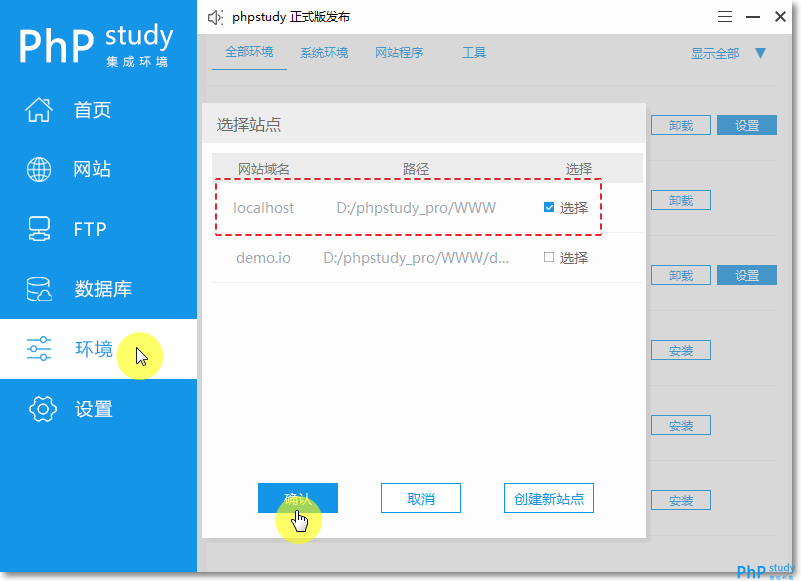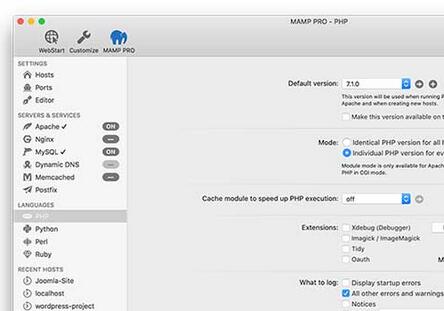Phpstudy For Mac
What is phpStudy? PhpStudy is a program integration package for a PHP debugging environment. The package integrates the latest Apache+PHP+MySQL+phpMyAdmin+Zend Optimizer. It can be installed at one time and used without configuration. It is a very convenient and useful PHP debugging environment. The program includes not only the PHP debugging environment, but also the development tools, development manuals and so on. In a word, it only needs one package to learn PHP. For novice PHP learners, environment configuration under WINDOWS is a very difficult task; for veterans, it is also a tedious task. So whether you are a novice or a veteran, the package is a good choice. Well, let’s go over the details of phpstudy‘s basic tutorial.
Please refer to the installation instructions on how to install Xdebug. Xdebug is hosted in GIT. The source code can be browsed through github. Download phpstudy for free. Our Help Desk Essentials pack allows you to respond to tickets quickly with remote support capabilities and track and measure technician performance to continuously improve customer satisfaction. Install Apache for Mac OS X. Mac OS is ultimately built on Unix so its very easy to install any Unix supporting softwares. Even better part is that Mac OS X comes with apache web server and we just need to start it and make some changes to setup our development environment. We will start apache server with root user to avoid any permission issues.
- Software Name:
- Phpstudy vc9-vc14 runtime (PHP runtime environment package) free installation version 64 bits
- Software size:
- 40.2MB
- Update time:
- 2017-03-17
- Software Name:
- PhpStudy (one-click installation package for PHP running environment) 2016.11.03 supports the latest official Chinese version of custom PHP version
- Software size:
- 36.33MB
- Update time:
- 2016-11-30
- Software Name:
- PhpStudy 2018 (PHP Running Environment One-Click Installation Package) v1.2.0.715 Official Latest Edition Supports Win10
- Software size:
- 59.9MB
- Update time:
- 2018-03-21
- Software Name:
- PhpStudy 2013 B PHP 5.2 Collection Edition (apache 2.2.25 + PHP 5.2.17)
- Software size:
- 11MB
- Update time:
- 2014-01-11
download
1. Search and download phpstudy directly in developpaer
2. Or open the phpstudy official website in the browser and download the installer on the official website. It can also be downloaded directly from Baidu.
install Shibram chakraborty short stories pdf.
1. The downloaded program is a zip compressed package. Among them, phpStudy20161103.exe is the installer, extract it, double-click installation.
2. After the installation program starts, a dialog box will pop up to indicate which directory to install; the default installation directory is D: phpStudy; you can modify it yourself;
3. Click on the confirmation button and the program will start to install.
When the installation is complete, phpstudy’s official website will be opened in the browser.
After installation, two shortcuts will be generated on the desktop, phpStudy startup program and usage manual.
Open the installation directory D: phpResearch in Resource Manager and you can see the installed files.
WWW is the default site root directory.
PhpStudy.exe is the startup program.
Manual. CHM is the official manual.
start-up
1. When the installation is completed, phpResearch will be started automatically, and a dialog box will pop up, prompting us to initialize, and click Yes.
2. Then, the main interface of phpStudy will pop up.
The program automatically starts Apache and MySQL services.
When you see the red dots behind Apache and MySQL text turn green, it means that the service started successfully.
If Apache service fails to start, you may have installed other WEB server programs (such as IIS) on your computer, and the default port 80 is occupied.
3. Then, click the “Other Options Menu” button in the lower right corner and select “My Home Page” to open the default homepage in the browser.
The default home page of the website shows the PHP probe, which shows the details of the PHP module supported on the server.
This page corresponds to the D: phpStudy WWW L. PHP file.
Modify the default home page
1. Open the default website root directory D: phpStudy WWW;
Right-click, new, text document, double-click open;
File Content Input
<?php
Echo: “Hello! “;
Documents, save as;
Enter the file name index. PHP in the pop-up dialog box and select “All Files” for the file type.
Click Save.
2. In the main interface of PHP Study, click on the “other options menu” button in the lower right corner and select “My Home Page”, you can see that the browser opened shows the contents of the newly created index.php file “Hello”. Next, you can modify the contents of the index.php file and write PHP code to learn php. Language.
Multi-domain name and multi-site configuration
1. In the main interface of phpStudy, click “MySQL Manager” and select “Site Domain Name Management”.

2. In the pop-up dialog box
1. Enter the domain name you want to use, such as: a.com
2. Select a website directory, such as: D: phpStudy WWW a
3. Leave “Second Domain Name” and “Website Port” blank
4. Click “Save Settings and Generate Configuration Files”
5. Pop-up prompt “saved successfully, program restart takes effect”, click OK
6. Apache service will automatically restart
3. In the main interface of phpStudy, click on “Other Options Menu”
Select “Open hosts”
In the open TXT document, enter the last line
127.0.0.1 a.com
Save and close.

4. According to the “Select Website Catalogue” settings in Step 2, under folder a of D: phpStudy WWW New folder, create a new index.php file and enter <? Php? Echo “This is the home page of a.com website”;
5. In the main interface of phpStudy, click the “Restart” button
Open the browser, enter a.com, return
As you can see, the contents of index. PHP file in folder a are displayed in the browser.
Repeat the steps above to create more domain names and sites.
Website Deployment
1. Copy all files in uploads directory to D: phpStudy WWW a
2. Open the browser and enter a.com
You can see the website installation interface
Select “I have read and agreed to this agreement” and click to proceed with the installation.
When you need to enter a database password, enter root
Click Continue to Install

3. After installation, you can see the prompt information.
You can choose to visit the homepage of the website or manage the homepage in the background.
uninstall
1. Open the task manager and finish the following three tasks 1, MySql.exe2, httpd.exe3, httpd.exe
2. Delete directory D: phpStudy and uninstall successfully! Note that before uninstalling, backup the useful website files under the WWW directory.
At the end of the article, the basic course of phpstudy: phpstudy download, installation, start-up, configuration, website deployment, uninstallation and other related content, the editor will introduce you here, I hope you like it!
Relevant recommendations:
PHPstudy Modify Upload File Limit Size Limit Method
MYSQL Establishes Independent Database and User Detailed Tutorial for Independent Database (PHPstudy MySQL-Front)
Php Study2016 User Tutorial for PHP Local Environment
macOS Update: While these instructions still work, there are new posts for recent versions of macOS, the latest being Install Apache, PHP, and MySQL on macOS Mojave.
PHP Update: Mac OS X El Capitan comes pre-installed with PHP version 5.5 which has reached its end of life. After you complete this post, you should upgrade PHP on Mac OS X.
Note: This post is for new installations. If you have installed Apache, PHP, and MySQL for Mac OS X Yosemite, read my post on Updating Apache, PHP, and MySQL for Mac OS X El Capitan.
Mac OS X runs atop UNIX. So most UNIX software installs easily on Mac OS X. Furthermore, Apache and PHP come packaged with Mac OS X. To create a local web server, all you need to do is configure Apache and install MySQL.
I am aware of the web server software available for Mac OS X, notably MAMP. These get you started quickly. But they forego the learning experience and, as most developers report, can become difficult to manage.
Running Commands

First, open the Terminal app and switch to the root user so you can run the commands in this post without any permission issues:
Enable Apache on Mac OS X
Phpstudy For Mac
Verify It works! by accessing http://localhost
Enable PHP for Apache
First, make a backup of the default Apache configuration. This is good practice and serves as a comparison against future versions of Mac OS X.
Now edit the Apache configuration. Feel free to use TextEdit if you are not familiar with vi.
Uncomment the following line (remove #):
Restart Apache:
You can verify PHP is enabled by creating a phpinfo() page in your DocumentRoot.
The default DocumentRoot for Mac OS X El Capitan is /Library/WebServer/Documents. You can verify this from your Apache configuration.
Now create the phpinfo() page in your DocumentRoot:
Verify PHP by accessing http://localhost/phpinfo.php
Install MySQL on Mac OS X El Capitan
Download and install the latest MySQL generally available release DMG for Mac OS X.
The README suggests creating aliases for mysql and mysqladmin. However there are other commands that are helpful such as mysqldump. Instead, you can update your path to include /usr/local/mysql/bin.
Note: You will need to open a new Terminal window or run the command above for your path to update.
Finally, you should run mysql_secure_installation. While this isn't necessary, it's good practice to secure your database.
Connect PHP and MySQL
You need to ensure PHP and MySQL can communicate with one another. There are several options to do so. I do the following:
Phpstudy Mac版本
Additional Configuration (optional)

The default configuration for Apache 2.4 on Mac OS X seemed pretty lean. For example, common modules like mod_rewrite were disabled. You may consider enabling this now to avoid forgetting they are disabled in the future.
Download Phpstorm
I edited my Apache Configuration:
I uncommented the following lines (remove #):
If you develop multiple projects and would like each to have a unique url, you can configure Apache VirtualHosts for Mac OS X.
If you would like to install PHPMyAdmin, return to my original post on installing Apache, PHP, and MySQL on Mac OS X.
Phpstudy For Macbook Air
Find this interesting? Let's continue the conversation on Twitter.